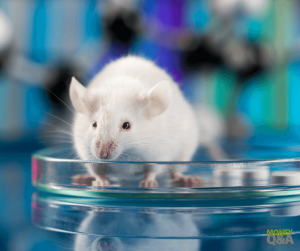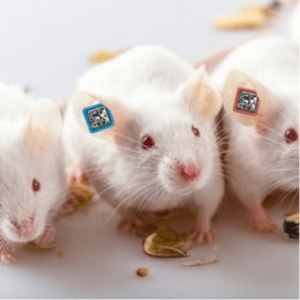
Rats are lonely creatures. Who likes a rat? But, little mice are another thing. Cute, furry, twitching nose, who can hate a mouse? What about mouse ear tags?
Cute may be why people empathize with the treatment of laboratory mice. After all, they are bred to be experiments in research. But, suppose there was a design feature that improves their treatment.
Suppose there were designer mice.
Mice are selectively bred to prepare them for research. They are systematically bred to have certain chromosomes and specific DNA to respond to trials.
According to its guide on handling and treating lab animals, Novartis AG (Basil, Switzerland) says, “Nowadays, an enormous number of different inbred and outbred mouse strains, including genetically modified mouse lines are available and used in research laboratories worldwide.”
So, there may be cages of similar looking mice who are distinctively different because their genes have been engineered.
Lab mice are further differentiated according to age, gender, and breed. Some labs still put the mice through pain when they mark their identity.
Some labs notch their ears, tattoo their skin, metal tags, or microchip implants. Each method causes some pain, and some fall off, wear off, or get chewed on before the experiment is over.
And, given how most mice look the same, they can be routinely agitated and over-handled by lab assistants who have difficulty distinguishing one mouse or group of mice from another.
Suppose there is a designer mouse.

According to Brett Swope, President of RapID Lab, automated mouse ear tags offer “greatly support researchers in their day-to-day work, contribute to animal welfare, and increase animal ID security.”
For example, the RapID Tag® rides the mouse’s ear. These tags come in vivid primary colors which are coded as determined by lab protocol. They are made of durable polymer that avoids rusting, cutting, and infection.
Each tag also sports a hardened 2-D scannable barcode that contains the specific test history of that mouse. Such barcodes allow millions of unique identities, and those codes integrate with a primary lab database.
The tags mount like a pierced earring through a small hole made by a special hand tool. Their hardened material will survive the heat in autoclave sterilization.
Containing no metal, the tags will not interfere with Magnetic Resonance Imaging (MRI). And, since the barcodes are easily replaced, the tags can be reused repeatedly
Why make it easy on the mouse?
The Association for Assessment and Accreditation of Laboratory Animal Care International accredits laboratories on their handling and treatment of test animals.
Accreditation is not required, but having the approval of the AAALAC makes it easier for labs to get investor and government funding.
And, the National Institutes of Health offers its Guide for the Care and Use of Laboratory Animals (8th edition) “to provide information that will enhance animal well-being, the quality of research, and the advancement of scientific knowledge that is relevant to both humans and animals”
But, regulations aside, it is in the interest of good science to treat lab mice well. They need to be protected from infection, disease, and extremes that would invalidate the testing.
Handling must avoid agitating them because anxious animals are not good test subjects. And, it is vital to secure, store, and process the data specific to mouse and test.
Finally, what’s bad for the mouse is bad for the lab. Inaccurate and confused data ruins the experiment, necessitates retesting, increasing the cost of the experiment, and replacing the mice.
So, in a way, there are designer lab mice out there, and they can best serve the needs of scientific testing. Such a simple yet scientifically elegant solution is a win-win for lab and mouse.
